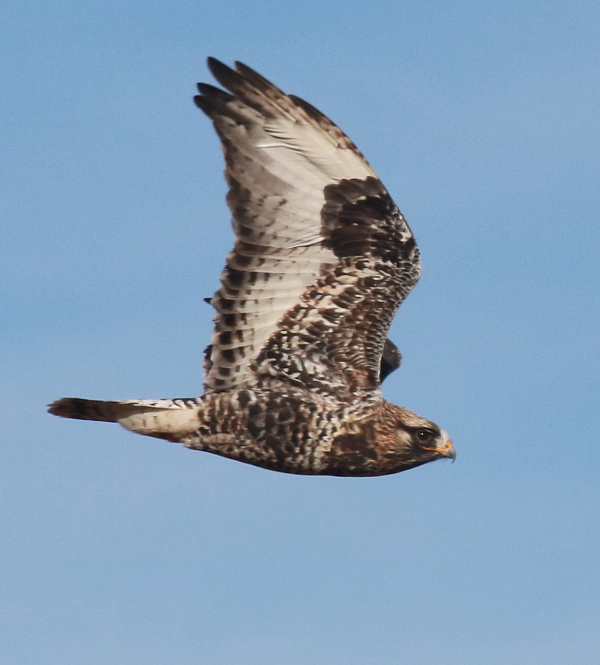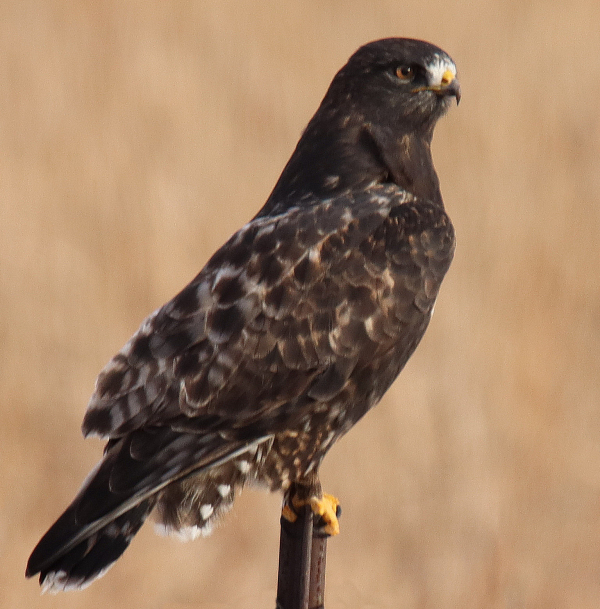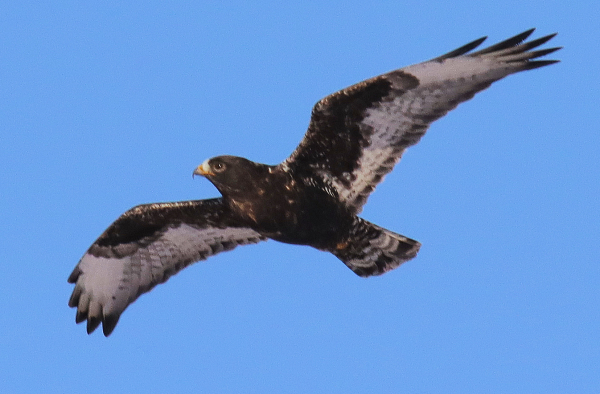
Male Rough-legged Hawks made up a significant percentage of the 9-plus hawks observed in the valley.

The most trusting Rough-leg was this impressive dark morph bird that provided a few memorable portrait photos.

Gliding into a strong west wind last Sunday, this was 1 of 2 dark morph Rough-legged Hawks hunting on the updraft from the highest hill.

A female Rough-leg in flight above the slope of a wintery hillside.
|
I was surprised to see 4, then 6, then 8 Rough-legged Hawks just 10 miles west of my office, hovering, flying, soaring, hunting, and even playing in the sky above a vast prairie, mostly on the north side of the tallest hill in the area. That was last Wednesday on my way to Bismarck, and there would be more Rough-legs widely scattered as I drove west to the Missouri River, 7 more; then 1 more miles after I turned north toward the capitol city for a total of 16 for the drive. Closer to Bismarck a dark morph Harlan’s Red-tailed Hawk added a little excitement, but the crowning touch came at sunset when I found a Short-eared Owl, with a second Short-ear 50 yards away! One was perched at the top of a tree and permitted me to photograph it in the fading sunset light.
Along the northern segment of my travel there was also a Northern Shrike, 5 Ring-necked Pheasants, and 2 flocks of Wild Turkeys numbering about 40 and 7. It was interesting to see 2 turkeys in the second flock fly 35 and 60 feet high to perch in a tall tree above the rest of the flock. Three flights of Canada Geese were also evident as they flew from open water areas of the river to harvested fields to feed, each numbering between 20 and 60.
Back to the Rough-legged Hawks observed Wednesday: Considering that I hadn’t seen any raptors along the first hour’s drive west of home 8 days earlier, the presence of 14 Rough-legged Hawks along the transect indicated a movement of these Arctic-nesting hawks into the region. The idea that these birds were moving south is also underlined by the fact that I only saw 12 Rough-legs last week in the Pierre area. During the past week, much of the first blizzard’s snowfall melted, providing more open grasslands for the hawks to hunt for voles and mice, and I hoped they would continue to populate the hotspot located just 10 miles west of home.
Return to Hawk Valley
The next afternoon, Thursday, I was hoping to re-locate some of the Rough-legged Hawks observed just 10 miles west of home. A good omen was seeing the first hawk just 6 miles to the west, and as my car climbed the big hill where the hawks centered before, I slowed down and watched intently for any hawks in flight, or perched, but no hawks were evident. Nonetheless, I pulled into an approach to view the area, somewhat taken aback by the fact that the sky was empty.
I did see a dark form on the ground in the midst of a distant marsh, and thinking it might be a hawk or a raccoon, I raised my binoculars to see it was a raptor, but it turned out to be a small Golden Eagle, and adult male! It was feeding, pulling on a carcass that showed fresh meat on prey. The surprise eagle continued to feed as I watched, but soon seemed to finish, took a few steps to the left to investigate a something on the ground, then took flight. Would the eagle wing in my direction for closer photos? I took a couple images of it flying low just above the tall prairie grasses as it climbed the angle of the big hill. Would it perch at the top of the hill?
Halfway up the hillside it vanished from view in a crease landscape, never rising to the hilltop that I could see plainly. I waited a bit, glassed with my binoculars over and over, and watched for hawks too. The hawks may well have been displaced by the eagle, and as I drove across the broad valley basin to the east I wondered what might have become of the Rough-legs. Suddenly, one zoomed upward fairly close and began hovering on the hunt. It looked to be a dark morph Rough-leg, which I verified as I watched it take hovering positions, then perch on a low post. Almost immediately after the first hawk perched, another normal-colored Rough-leg appeared in hunting mode, making aggressive dives, presumably toward prey and resulting in an apparent catch when it stayed on the ground for an extended period.
I scanned the area, then decided to drive south 2 miles along a one-lane track, where I sighted a distant Rough-leg on the hunt – and an adult Bald Eagle perched in a low tree. It’s interesting to note that the Bald Eagle was only a mile away from the Golden Eagle – a rare chance to see both North American species so close within such a short time frame. Goldens are very rare in the open plains of this region, and although Bald Eagles are relatively common, this time of year they have become few and far between. I turned back and retraced my route to the area where I left the first 2 Rough-legs, but didn’t see any at first. Continuing east a half-mile, I saw 1, then 2, then 5 hawks, all perched within a 50 yard space – 1 “normally” colored Rough-leg, 2 dark morphs, and 2 adult males!
I photographed one of the males, then moved forward to photograph one of the dark morph hawks as it perched on a low fence post. I had a nice view of the black hawk broadside and took a couple photos before it turned to look in my direction, which made the white plumage around its beak stand out. Appreciating how lucky I was to have the hawk dismiss my approach, I noticed some white spotting on its black plumage, which should show up well in the photographs I was taking. Other hawks began taking flight, and this fine foto subject followed after another moment’s hesitation. Almost immediately the 5 hawks began hunting roughly a quarter-mile to the south for a time, which was quite a sight, until 3 of the hawks began circling into a soaring flight that brought them back in my direction, with an especially black dark morph circling overhead for a few photos.
I spent a bit more time in the area, about an hour overall, but I was also interested in doing a raptor survey that included a circle route that I refer to as my raptor drive, which I most often check during the early dispersal and migration period during August and September. The previous day’s hawk observations indicated an in-flight of Rough-legs across the region, so I was anxious to see if it may have brought hawks into a greater area to the north too. Hoping for the best, I only found a single Rough-leg on the far end of my extended circle drive. And when I returned to the hawk hotspot before sunset, no raptors were evident – oh well. It was insightful to see that this area was a local focal area.
This was the same broad valley, mostly covered by tall grass and surrounded by high prairie hills, where I observed and photographed a concentration of Northern Harriers earlier this fall. The open grasslands obviously produce an abundance of voles and mice that attract numbers of raptors that specialize in hunting these microtine populations. The resurgence of hawks there leads me to wish to refer to this area as “Hawk Valley” (even though there were 2 eagles in the mix Thursday – ha).
I drove home, but was compelled to continue a couple miles south before calling it a day, which revealed a Great Horned Owl hunting at sunset a bit more than a mile south of my office. I haven’t seen or heard the species for some time, so it was a welcome sighting. That location is favored by Great Horned Owls, so it would be nice if this one stayed around a while. Looking ahead, as nice as this afternoon was, overnight a freezing Arctic wind would blast a subzero wind chill across this land, and I wondered how many of the predatory birds would remain when the sun emerged again Saturday.
Saturday Return
Even with a light wind and sunshine, it looked bleak for finding birds as I returned to Hawk Valley with hopes of seeing a few raptors as I drove across the entire area, about 3 miles, without a hint of a hawk. I stopped to overlook an expanse of grassland and frozen marsh and quickly located a distant Rough-leg on the wing. I followed its movements a bit until it met a second hawk in flight, which made me want to explore the area more and try to get into position to intercept a flight for photographs. Backtracking a mile, I turned south and quickly noted a dark morph Rough-leg that took wing, I tried to intercept it as it began circling in soaring flight, and managed what would be my best photos of the afternoon.
I followed the bird’s movements as it hunted above the expanse of tall prairie grass, but finally pressed forward to check the little grove of trees where the Bald Eagle perched 2 days before. As I reached the top of the low hill, I was surprised to see 4 Rough-legs perched in the eagle trees. I continued down the road until I was in just the right position with the sun at my back and the hawks before me, and eventually 1, then 2 hawks flew a little nearer – one returning to the trees and the other beginning a hunt. So now I had 5 Rough-legs to my left, and 4 to my right; that was a high count of 9 for Hawk Valley. Apparently these Arctic-nesting hawks were unaffected by the Arctic blast the previous day and night, or the plentiful rodent population kept them tuned into this open grassland expanse.
I spent the next 2 hours observing the hawks, usually 1 but sometimes 2 at a time, as they hunted on the wing and from perches, but didn’t get much more in the way of photo ops. Even so, sunshine was predicted for Sunday, so I expected I’d be back. The variety of plumages among the Rough-legs in this “group” was very interesting, including at least 1 black and 1 chocolate-brown dark morphs, 3 or 4 silver-gray males, and at least 3 different plumage types among the “normal” female or first-year immature hawks. My photo luck had been running best with the dark morph hawks, and I looked forward to Sunday’s action.
More Valley Visits
Anxious, or even over-anxious, I opted for a Sunday morning return to Hawk Valley, but aside from the beautiful sunshine and cold temperature, it offered no indication of any raptors for the first half-hour. Eventually, at a rate of about 1 per 30 minutes, I observed a total of 4 Rough-legs scattered in the heart of the prairie basin, a bit east of the previous activity centers. The fourth hawk was a dark morph, but the other 3 were beautiful examples of the species, especially the only hawk to provide a series of flight photos during the morn.
By mid-afternoon, with temperatures warming to a degree or 2 above freezing, I returned during mid-afternoon with the hope the hawks would be more active, although the wind increased considerably compared to the morning session. Right away I found 2 Rough-legs on the hunt along the northwest side of the big hill on the east side of the valley, a behavior I hadn’t seen since Wednesday. In short order, one of the dark morph hawks began gliding ever lower into the wind in my direction, which provided an exciting photo session as the sleek raptor sliced through the wind.
Overall, the hawks were more active, with 2 duos on site, including 3 dark morph Rough-legs and 1 with normal plumage. I enjoyed 3 photo opportunities while observing their hunting and resting activities. Grouse were active too, with groups of 5, 1, and 2 Sharp-tails evident. I certainly made the most of the last sunny day for a while, with snow and winds predicted Monday thru Wednesday.
Monday was cloudy with impressions of clearing that led me to head back to Hawk Valley to check the status of the hawk count, which turned out to be at least 3 Rough-legs, including 1 dark morph – and a flock of 9 Sharp-tailed Grouse. I can’t over-emphasize how exciting it was to have the Rough-legged Hawks key in on the Hawk Valley – just 10 miles away. The area had become something of a birding desert for a couple weeks before that, so to have the hawks, with their diversity of plumages so close at hand day after day has been a real thrill. And it’s been interesting to see how the birds populate and move around the valley during my observation periods and to monitor their behavior. It’s really been a fun “hawk week” in Hawk Valley!
Article and photos by Paul Konrad
Share your bird sightings and photographs at editorstbw2@gmail.com